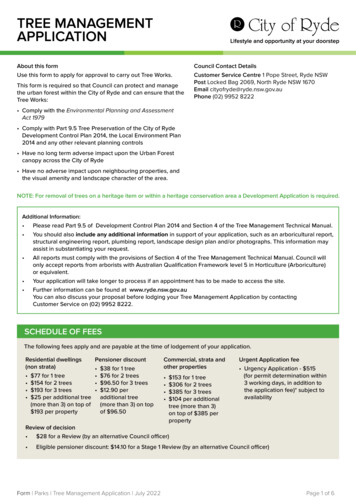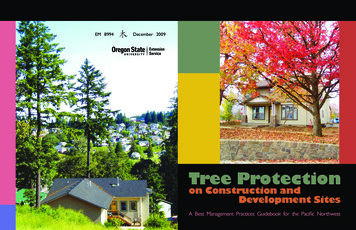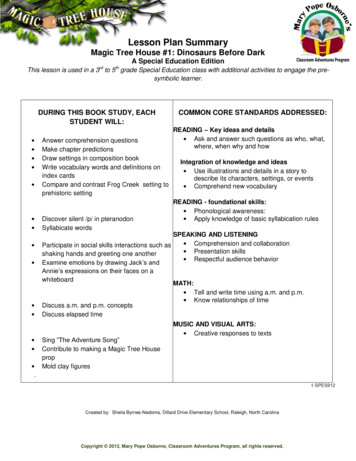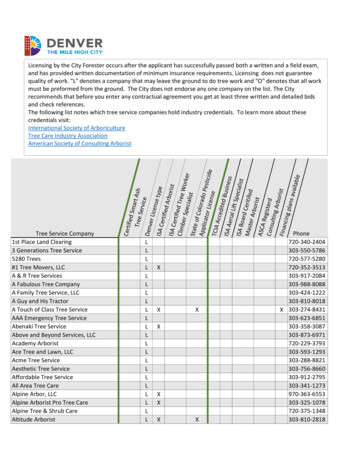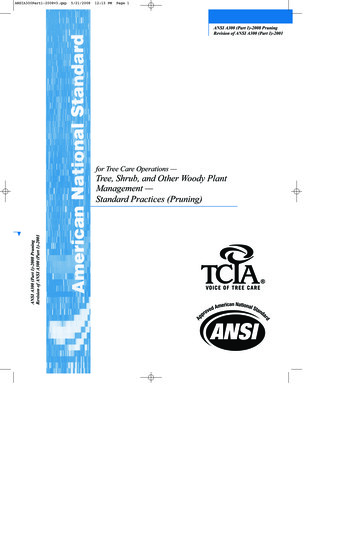
Transcription
ANSIA300Part1-2008v3.qxp5/21/200812:13 PMPage 1ANSI A300 (Part 1)-2008 PruningRevision of ANSI A300 (Part 1)-2001for Tree Care Operations —ANSI A300 (Part 1)-2008 PruningRevision of ANSI A300 (Part 1)-2001Tree, Shrub, and Other Woody PlantManagement —Standard Practices (Pruning)
ANSIA300Part1-2008v3.qxp5/21/200812:13 PMPage 3ANSI A300 (Part 1)-2008for Tree Care Operations —Tree, Shrub, and Other Woody Plant Management —Standard Practices (Pruning)SecretariatTree Care Industry Association, Inc.Copyright 2008 by the Tree Care Industry AssociationAll rights reserved.Tree Care Industry Association, Inc.136 Harvey Road - Suite B101-B110Londonderry, NH 030531-800-733-2622(603) 314-5380Fax: (603) 314-5386E-mail: Rouse@tcia.orgWeb: www.tcia.org
tandard12:13 PMPage 5Approval of an American National Standard requires review by ANSI that the requirementsfor due process, consensus, and other criteria for approval have been met by the standards developer.Consensus is established when, in the judgement of the ANSI Board of Standards Review,substantial agreement has been reached by directly and materially affected interests.Substantial agreement means much more than a simple majority, but not necessarily unanimity. Consensus requires that all views and objections be considered, and that a concerted effort be made toward their resolution.The use of American National Standards is completely voluntary; their existence does notin any respect preclude anyone, whether he has approved the standards or not, from manufacturing, marketing, purchasing or using products, processes or procedures not conforming to the standards.The American National Standards Institute does not develop standards and will in no circumstances give an interpretation of any American National Standard. Moreover, no person shall have the right or authority to issue an interpretation of an American NationalStandard in the name of the American National Standards Institute. Requests for interpretations should be addressed to the secretariat or sponsor whose name appears on the titlepage of this standard.CAUTION NOTICE: This American National Standard may be revised or withdrawn at anytime. The procedures of the American National Standards Institute require that action betaken periodically to reaffirm, revise, or withdraw this standard. Purchasers of AmericanNational Standards may receive current information on all standards by calling or writingthe American National Standards Institute.Published byTree Care Industry Association, Inc.,136 Harvey Road - Suite B101-B110, Londonderry, NH 03053Phone:1-800-733-2622 or (603) 314-5380 Fax: (603) 314-5386E-mail: tcia@tcia.orgWeb: www.tcia.orgCopyright 2008 by the Tree Care Industry AssociationAll rights reserved.No part of this publication may be reproduced in anyform, in an electronic retrieval system or otherwise,without prior written permission of the publisher.Printed in the United States of America
ANSIA300Part1-2008v3.qxp5/21/200812:13 PMPage 6ContentsForeword123456789Page .iiANSI A300 Standards – Scope, purpose, and application .1Part 1 – Pruning Standards .1Normative References .1Definitions .1Pruning practices .4Pruning objectives .6Pruning methods (types)* .7Palm pruning .7Utility pruning .8Figures4.45.3.25.3.35.3.88.3a8.3bStandard branch definitions .2A cut that removes a branch at its point of origin .5A cut that reduces the length of a branch or parent stem .5A cut that removes a branch with a narrow angle of attachment. .5Frond removal location .7An overpruned palm .8Annex A – Pruning cut guideline .10Annex B – Specification writing guideline .11Annex C – Applicable ANSI A300 interpretations .13* The term pruning type is replaced with the term pruning method. The purpose of this is to label theprocesses detailed in section 6 with greater accuracy.iTree Care Industry Associationwww.tcia.org
ANSIA300Part1-2008v3.qxp5/21/200812:13 PMPage 7Foreword This foreword is not part of American National Standard A300 (Part 1)-2008PruningANSI A300 Standards are divided into multiple parts, each focusing on a specific aspect of woody plantmanagement (e.g. Pruning, Fertilization, etc).These standards are used to develop written specifications for work assignments. They are not intended tobe used as specifications in and of themselves. Management objectives may differ considerably and therefore must be specifically defined by the user. Specifications are then written to meet the established objectives and must include measurable criteria.ANSI A300 standards apply to professionals who provide for or supervise the management of trees,shrubs, and other woody landscape plants. Intended users include businesses, government agencies,property owners, property managers, and utilities. The standard does not apply to agriculture, horticultural production, or silviculture, except where explicitly noted otherwise.This standard has been developed by the Tree Care Industry Association (TCIA), an ANSI-accreditedStandards Developing Organization (SDO). TCIA is secretariat of the ANSI A300 standards, and developsstandards using procedures accredited by the American National Standards Institute (ANSI).Consensus for standards writing was developed by the Accredited Standards Committee on Tree, Shrub,and Other Woody Plant Management Operations – Standard Practices, A300 (ASC A300).Prior to 1991, various industry associations and practitioners developed their own standards and recommendations for tree care practices. Recognizing the need for a standardized, scientific approach, greenindustry associations, government agencies and tree care companies agreed to develop consensus for anofficial American National Standard.The result – ANSI A300 standards – unify and take authoritative precedence over all previously existingtree care industry standards. ANSI requires that approved standards be developed according to acceptedprinciples, and that they be reviewed and, if necessary, revised every five years.TCIA was accredited as a standards developing organization with ASC A300 as the consensus body onJune 28, 1991. ASC A300 meets regularly to write new, and review and revise existing ANSI A300 standards. The committee includes industry representatives with broad knowledge and technical expertisefrom residential and commercial tree care, utility, municipal and federal sectors, landscape and nurseryindustries, and other interested organizations.Suggestions for improvement of this standard should be forwarded to: A300 Secretary,c/o Tree Care Industry Association, Inc., 136 Harvey Road - Suite B101-B110, Londonderry, NH, 03053.ANSI A300 (Part 1)-2008 Pruning was approved as an American National Standard by ANSI on May 1,2008. ANSI approval does not require unanimous approval by ASC A300. The ASC A300 committee contained the following members at the time of ANSI approval:Tim Johnson, Chair(Artistic Arborist, Inc.)Bob Rouse, Secretary(Tree Care Industry Association, Inc.)(Continued)Tree Care Industry Associationwww.tcia.orgii
ANSIA300Part1-2008v3.qxp5/21/200812:13 PMPage 8Organizations RepresentedName of RepresentativeAmerican Nursery and Landscape Association. Warren QuinnCraig J. Regelbrugge (Alt.)American Society of Consulting Arborists . Donald ZimarAmerican Society of Landscape Architects . Ron LeightonAsplundh Tree Expert Company . Geoff KempterPeter Fengler (Alt.)Bartlett Tree Expert Company . Peter BeckerDr. Thomas Smiley (Alt.)Davey Tree Expert Company. Joseph TommasiR.J. Laverne (Alt.)International Society of Arboriculture . Bruce HagenSharon Lilly (Alt.)National Park Service . Robert DeFeoDr. James Sherald (Alt.)Professional Grounds Management Society . Thomas ShanerProfessional Land Care Network . Preston LeyshonSociety of Municipal Arborists . Gordon MannAndy Hillman (Alt.)Tree Care Industry Association . Dane BuellJames McGuire (Alt.)USDA Forest Service . Ed MacieKeith Cline (Alt.)Utility Arborist Association . Matthew SimonsJeffrey Smith (Alt.)Additional organizations and individuals:American Forests (Observer)Mike Galvin (Observer)Peter Gerstenberger (Observer)Dick Jones (Observer)Myron Laible (Observer)Beth Palys (Observer)Richard Rathjens (Observer)Richard Roux (NFPA-780 Liaison)ASC A300 mission statement:Mission: To develop consensus performance standards based on current research andsound practice for writing specifications to manage trees, shrubs, and other woody plants.iiiTree Care Industry Associationwww.tcia.org
ANSIA300Part1-2008v3.qxp5/21/200812:13 PMPage 1American National StandardAmerican National Standardfor Tree Care Operations –Tree, Shrub, and OtherWoody PlantManagement –Standard Practices(Pruning)1ANSI A300 standards1.1ScopeANSI A300 (Part 1)-20082.3Implementation2.3.1 Specifications for pruning should be writtenand administered by an arborist.2.3.1.1 Specifications should include location oftree(s), objectives, methods (types), and extent ofpruning (location, percentage, part size, etc).2.3.2Pruning specifications shall be adhered to.2.4Safety2.4.1 Pruning shall be implemented by anarborist, familiar with the practices and hazards ofpruning and the equipment used in such operations.ANSI A300 standards present performance standards for the care and management of trees,shrubs, and other woody plants.2.4.2 This performance standard shall not takeprecedence over applicable industry safe workpractices.1.22.4.3 Performance shall comply with applicableFederal and State Occupational Safety and Healthstandards, ANSI Z133.1, Federal Insecticide,Fungicide, and Rodenticide Act (FIFRA) and otherFederal Environmental Protection Agency (EPA)regulations, as well as state and local regulations.PurposeANSI A300 performance standards are intendedfor use by federal, state, municipal and private entities including arborists, property owners, propertymanagers, and utilities for developing written specifications.1.3ApplicationANSI A300 performance standards shall apply toany person or entity engaged in the managementof trees, shrubs, or other woody plants.2Part 1 – Pruning standards2.1PurposeThe purpose of Part 1 – Pruning is to provide performance standards for developing written specifications for pruning.2.2Reasons for pruningThe reasons for tree pruning may include, but arenot limited to, reducing risk, managing tree healthand structure, improving aesthetics, or achievingother specific objectives. Pruning practices foragricultural, horticultural production, or silviculturalpurposes are exempt from this standard unlessthis standard, or a portion thereof, is expressly referenced in standards for these other related areas.3Normative referencesThe following standards contain provisions, which,through reference in the text, constitute provisionsof this American National Standard. All standardsare subject to revision, and parties to agreementsbased on this American National Standard shallapply the most recent edition of the standards indicated below.ANSI Z60.1, Nursery stockANSI Z133.1, Arboriculture – Safety requirements29 CFR 1910, General industry 1)29 CFR 1910.268, Telecommunications 1)29 CFR 1910.269, Electric power generation,transmission, and distribution 1)29 CFR 1910.331 - 335, Electrical safety-relatedwork practices 1)4Definitions4.1arboriculture: The art, science, technology, and business of commercial, public, and utilitytree care.1) Available from U.S. Department of Labor, 200 Constitution Avenue, NW, Washington, DC 20210Tree Care Industry Associationwww.tcia.org1
ANSIA300Part1-2008v3.qxp5/21/200812:13 PMPage 2American National Standard4.2arborist: An individual engaged in theprofession of arboriculture who, through experience, education, and related training, possessesthe competence to provide for or supervise themanagement of trees and other woody plants.4.3arborist trainee: An individual undergoing on-the-job training to obtain the experience andthe competence required to provide for or supervise the management of trees and other woodyplants. Such trainees shall be under the directsupervision of an arborist.4.4branch: A shoot or stem growing from aparent branch or stem (See Fig. 4.4).4.4.1 codominant branches/codominant leaders: Branches or stems arising from a commonjunction, having nearly the same size diameter(See Fig. 4.4).4.4.2 lateral branch: A shoot or stem growingfrom another branch (See Fig. 4.4).4.4.3 parent branch or stem: A tree trunk orbranch from which other branches or shoots grow(See Fig. 4.4).4.4.4 scaffold branch: A primary branch thatforms part of the main structure of the crown (SeeFig. 4.4).ANSI A300 (Part 1)-20084.5branch bark ridge: The raised area ofbark in the branch crotch that marks where thebranch and parent stem meet. (See Figs. 5.3.2 and5.3.3).4.6branch collar: The swollen area at thebase of a branch.4.7callus: Undifferentiated tissue formed bythe cambium around a wound.4.8cambium: The dividing layer of cells thatforms sapwood (xylem) to the inside and innerbark (phloem) to the outside.4.9clean: Selective pruning to remove one ormore of the following non-beneficial parts: dead,diseased, and/or broken branches (7.2).4.10climbing spurs: Sharp, pointed devicesstrapped to a climber’s lower legs used to assist inclimbing trees. (syn.: gaffs, hooks, spurs, spikes,climbers)4.11closure: The process in a woody plant bywhich woundwood grows over a pruning cut orinjury.4.12crown: Upper part of a tree, measuredfrom the lowest branch, including all the branchesand foliage.4.13decay: The degradation of woody tissuecaused by microorganisms.4.14espalier: The combination of pruning,supporting, and training branches to orient a plantin one plane (6.5).4.15establishment: The point after plantingwhen a tree’s root system has grown sufficientlyinto the surrounding soil to support growth andanchor the tree.4.16facility: A structure or equipment used todeliver or provide protection for the delivery of anessential service, such as electricity or communications.4.17frond: A leaf structure of a palm.4.18heading: The reduction of a shoot, stem,or branch back to a bud or to a lateral branch notlarge enough to assume the terminal role.Figure 4.4 Standard branch definitions.2Tree Care Industry Associationwww.tcia.org
ANSIA300Part1-2008v3.qxp5/21/200812:13 PMPage 3American National Standard4.19interfering branches: Crossing, rubbing,or upright branches that have the potential to damage tree structure and/or health.4.20internode: The area between lateralbranches or buds.4.21job briefing: The communication of atleast the following subjects for arboricultural operations: work specifications, hazards associated withthe job, work procedures involved, special precautions, electrical hazards, job assignments, and personal protective equipment.4.22leader: A dominant, typically upright, stem– usually the main trunk. There can be severalleaders in one tree.4.23lion’s tailing: The removal of an excessive number of inner and/or lower lateral branchesfrom parent branches. Lion’s tailing is not anacceptable pruning practice (6.1.7).4.24live crown ratio: Crown height relative tooverall plant height.ANSI A300 (Part 1)-20084.32qualified line-clearance arborist trainee:An individual undergoing line-clearance trainingunder the direct supervision of a qualified lineclearance arborist. In the course of such training,the trainee becomes familiar with the equipmentand hazards in line clearance and demonstratesability in the performance of the special techniquesinvolved.4.33raise: Pruning to provide vertical clearance (7.3).4.34reduce: Pruning to decrease heightand/or spread (7.4).4.35remote area: As used in the utility pruning section of this standard, an unpopulated area.4.36restoration: Pruning to redevelop structure, form, and appearance of topped or damagedtrees (6.3).4.37rural area: As used in the utility pruningsection of this standard, a sparsely populatedplace away from large cities, suburbs, or towns butdistinct from remote areas.4.25mechanical pruning: A pruning technique where large-scale power equipment is usedto cut back branches (9.3.2).4.38shall: As used in this standard, denotes amandatory requirement.4.26method: A procedure or process forachieving an objective.4.39shoot: Stem or branch and its leaves,especially when young.4.27peeling: The removal of dead frond baseswithout damaging living trunk tissue at the pointthey make contact with the trunk. (syn.: shaving)4.40should: As used in this standard, denotesan advisory recommendation.4.28petiole: A stalk of a leaf or frond.4.29pollarding: Pruning method in which treebranches are initially headed and then reduced ona regular basis without disturbing the callus knob(6.6).4.30pruning: The selective removal of plantparts to meet specific goals and objectives.4.31qualified line-clearance arborist: Anindividual who, through related training and on-thejob experience, is familiar with the equipment andhazards in line clearance and has demonstratedthe ability to perform the special techniquesinvolved. This individual may or may not be currently employed by a line-clearance contractor.Tree Care Industry Association4.41specifications: A document stating adetailed, measurable plan or proposal for provisionof a product or service.4.42sprouts: New shoots originating from epicormic or adventitious buds, not to be confused withsuckers. (syn.: watersprouts, epicormic shoots)4.43standard, ANSI A300: The performanceparameters established by industry consensus asa rule for the measure of extent, quality, quantity,value or weight used to write specifications.4.44stem: A woody structure bearing buds,foliage, and giving rise to other stems.4.45structural pruning: Pruning to improvebranch architecture (6.2).www.tcia.org3
ANSIA300Part1-2008v3.qxp5/21/200812:13 PMPage 4American National Standard4.46stub: Portion of a branch or stem remaining after an internodal cut or branch breakage.ANSI A300 (Part 1)-20084.60woundwood: Partially differentiated tissue responsible for closing wounds. Woundwooddevelops from callus associated with wounds.4.47subordination: Pruning to reduce thesize and ensuing growth rate of a branch or leaderin relation to other branches or leaders.5Pruning practices4.485.1Tree inspectionsucker: Shoot arising from the roots.4.49thin: pruning to reduce density of livebranches (7.5).5.1.1 An arborist or arborist trainee shall visuallyinspect each tree before beginning work.4.50throw line: A small, lightweight line with aweighted end used to position a climber’s rope in atree.5.1.2 If a condition is observed requiring attention beyond the original scope of the work, thecondition should be reported to an immediatesupervisor, the owner, or the person responsiblefor authorizing the work.4.51topping: Reduction of tree size usinginternodal cuts without regard to tree health orstructural integrity. Topping is not an acceptablepruning practice (6.1.7).4.52tracing: The removal of loose, damagedtissue from in and around the wound.4.53trunk: The main woody part of a treebeginning at and including the trunk flare andextending up into the crown from which scaffoldbranches grow.4.54trunk flare: 1. The area at the base of theplant’s trunk where it broadens to form roots. 2.The area of transition between the root system andtrunk (syn.: root flare).4.55urban/residential areas: Populated areasincluding public and private property that are normally associated with human activity.4.56utility: A public or private entity that delivers a public service, such as electricity or communications.4.57utility space: The physical area occupiedby a utility’s facilities and the additional spacerequired to ensure its operation.4.58vista/view prune: Pruning to enhance aspecific view without jeopardizing the health of thetree (6.4).5.1.3 Job briefings shall be performed as outlined in ANSI Z133.1, subclause 3.1.4.5.2Tools and equipment5.2.1 Equipment, tools, and work practices thatdamage living tissue and bark beyond the scope ofnormal work practices shall be avoided.5.2.2 Climbing spurs shall not be used whenentering and climbing trees for the purpose ofpruning.Exceptions:- when branches are more than throw-line distance apart and there is no other means ofclimbing the tree;- when the outer bark is thick enough to preventdamage to the inner bark and cambium;- in remote or rural utility rights-of-way.5.3Pruning cuts5.3.1 Pruning tools used in making pruning cutsshall be sharp.5.3.2 A pruning cut that removes a branch at itspoint of origin shall be made close to the trunk orparent branch without cutting into the branch barkridge or branch collar or leaving a stub (see Figure5.3.2).4.59wound: An opening that is created whenthe bark of a live branch or stem is cut, penetrated,damaged, or removed.4Tree Care Industry Associationwww.tcia.org
ANSIA300Part1-2008v3.qxp5/21/200812:13 PMPage 5American National StandardANSI A300 (Part 1)-20085.3.4 When pruning to a lateral, the remaininglateral branch should be large enough to assumethe terminal role.5.3.5 The final cut should result in a flat surfacewith adjacent bark firmly attached.5.3.6 When removing a dead branch, the finalcut shall be made just outside the collar of livingtissue.5.3.7 Tree branches shall be removed in such amanner so as to avoid damage to other parts ofthe tree or to other plants or property. Branchestoo large to support with one hand shall be precutto avoid splitting of the wood or tearing of the bark(see Figure 5.3.2). Where necessary, ropes orother equipment shall be used to lower largebranches or portions of branches to the ground.Figure 5.3.2. A cut that removes a branch at itspoint of origin. (See Annex A – Pruning cutguideline).5.3.3 A pruning cut that reduces the length of abranch or parent stem shall be made at a slightdownward angle relative to the remaining stem andnot damage the remaining stem. Smaller cutsshall be preferred (see Fig. 5.3.3).5.3.8 A cut that removes a branch with a narrowangle of attachment should be made from the outside of the branch to prevent damage to the parentbranch (see Figure 5.3.8).Figure 5.3.8. A cut that removes a branch witha narrow angle of attachment.5.3.9 Severed branches shall be removed fromthe crown upon completion of the pruning, at timeswhen the tree would be left unattended, or at theend of the workday.5.4Figure 5.3.3. A cut that reduces the length of abranch or parent stem.Tree Care Industry AssociationWound treatment5.4.1 Wound treatments shall not be used tocover wounds or pruning cuts, except when necessary for disease, insect, mistletoe, or sprout control, or for cosmetic reasons.www.tcia.org5
ANSIA300Part1-2008v3.qxp5/21/200812:13 PMPage 6American National StandardANSI A300 (Part 1)-20085.4.2 Wound treatments that are damaging totree tissues shall not be used.6.2.2 Dominant leader(s) should be selected fordevelopment as appropriate.5.4.3 When tracing wounds, only loose, damaged tissue shall be removed.6.2.3 Strong, properly spaced scaffold branchstructure should be selected and maintained byreducing or removing others.66.2.4 Temporary branches should be retained orreduced as appropriate.Pruning objectives6.1Pruning objectives shall be establishedprior to beginning any pruning operation.6.1.1 Objectives should include, but are not limited to, one or more of the following: Risk reduction Manage health Clearance Structural improvement/correction View improvement/creation Aesthetic improvement Restoration6.1.2 Established objectives should be specifiedin writing (See Annex B – Specification writingguideline).6.1.3 To obtain the defined objective, the growthcycles, structure, species, and the extent of pruning to be performed shall be considered.6.2.5 Interfering, overextended, defective, weak,and poorly attached branches should be removedor reduced.6.2.6 At planting, pruning should be limited tocleaning (7.2).6.3Restoration: Restoration shall consist ofselective pruning to redevelop structure, form, andappearance of severely pruned, vandalized, ordamaged trees.6.3.1 Location in tree, size range of parts, andpercentage of sprouts to be removed should bespecified.6.4Vista/view: Vista/view pruning shall consist of the use of one or more pruning methods(types) to enhance a specific line of sight.6.1.4 Not more than 25 percent of the foliageshould be removed within an annual growing season. The percentage and distribution of foliage tobe removed shall be adjusted according to theplant’s species, age, health, and site.6.4.1fied.6.1.5 When frequent excessive pruning is necessary for a tree to avoid conflicts with elementssuch as infrastructure, view, traffic, or utilities,removal or relocation of the tree shall be considered.6.56.1.6 Pruning cuts should be made in accordance with section 5.3 Pruning cuts.6.1.7 Topping and lion’s tailing shall be considered unacceptable pruning practices for trees.6.2Structural: Structural pruning shall consist of selective pruning to improve tree and brancharchitecture primarily on young- and medium-agedtrees.6.2.1 Size and location of leaders or branches tobe subordinated or removed should be specified.6Tree Care Industry AssociationPruning methods (types) shall be speci-6.4.2 Size range of parts, location in tree, andpercentage of foliage to be removed should bespecified.Espalier6.5.1 Branches that extend outside the desiredplane of growth shall be pruned or tied back.6.5.2 Ties should be replaced as needed to prevent girdling the branches at the attachment site.6.6Pollarding6.6.1 Consideration shall be given to the abilityof the individual tree to respond to pollarding.6.6.2 Management plans shall be made prior tothe start of the pollarding process for routineremoval of sprouts.www.tcia.org
ANSIA300Part1-2008v3.qxp5/21/200812:13 PMPage 7American National Standard6.6.3 Heading cuts shall be made at specificlocations to start the pollarding process. After theinitial cuts are made, no additional heading cutsshall be made.6.6.4 Sprouts growing from the cut ends ofbranches (knuckles) should be removed annuallyduring the dormant season.7ANSI A300 (Part 1)-20087.5.2 Not more than 25 percent of the crownshould be removed within an annual growing season.7.5.3 Location of parts to be removed shall bespecified.7.5.4 Percentage of foliage and size range ofparts to be removed shall be specified.Pruning methods (types)87.1One or more of the following methods(types) shall be specified to achieve the objective.7.2Clean: Cleaning shall consist of pruningto remove one or more of the following non-beneficial parts: dead, diseased, and/or broken branches.7.2.1 Location of parts to be removed shall bespecified.Palm pruning8.1Palm pruning should be performed whenfronds, fruit, or loose petioles may create a dangerous condition.8.2Live healthy fronds should not be removed.8.3Live, healthy fronds above horizontal shallnot be removed. Exception: Palms encroachingon electric supply lines (see Fig. 8.3a and 8.3b).7.2.2 Size range of parts to be removed shall bespecified.7.3Raise: Raising shall cons
4.3 arborist trainee:An individual undergo-ing on-the-job training to obtain the experience and the competence required to provide for or super-vise the management of trees and other woody plants. Such trainees shall be under the direct supervision of an arborist. 4.4 branch: A shoot or stem growing from a parent branch or stem (See Fig. 4.4).







